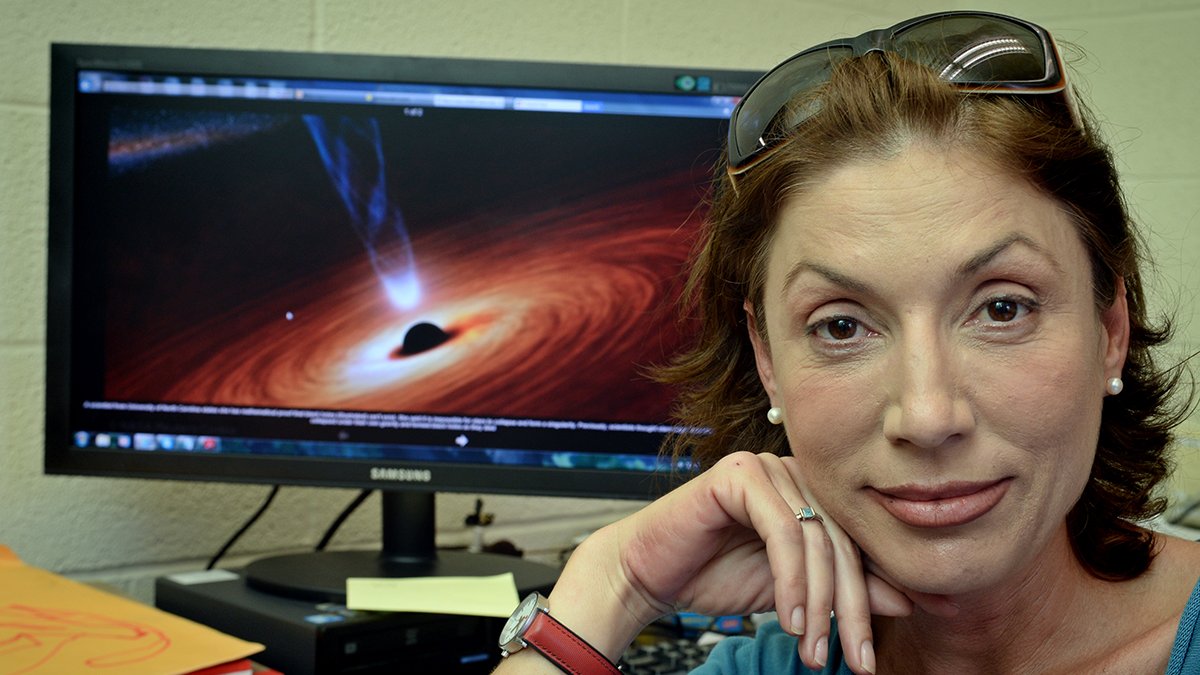Rethinking the origins of the universe
Laura Mersini-Houghton has mathematically proven that quantum effects are strong enough to stop the formation of black holes, work that opens up a new round of discussions and debates about the origins of the universe.

Black holes have long captured the public imagination and been the subject of popular culture, from Star Trek to Hollywood. They are the ultimate unknown – the blackest and most dense objects in the universe that do not even let light escape.
And as if they weren’t bizarre enough to begin with, now add this to the mix: they don’t exist.
By merging two seemingly conflicting theories, Laura Mersini-Houghton, a physics professor at UNC-Chapel Hill in the College of Arts and Sciences, has proven, mathematically, that black holes can never come into being in the first place. The work not only forces scientists to reimagine the fabric of space-time, but also rethink the origins of the universe.
“I’m still not over the shock,” said Mersini-Houghton. “We’ve been studying this problem for a more than 50 years and this solution gives us a lot to think about.”
For decades, black holes were thought to form when a massive star collapses under its own gravity to a single point in space – imagine the Earth being squished into a ball the size of a peanut – called a singularity. So the story went, an invisible membrane known as the event horizon surrounds the singularity and crossing this horizon means that you could never cross back. It’s the point where a black hole’s gravitational pull is so strong that nothing can escape it.
The reason black holes are so bizarre is that it pits two fundamental theories of the universe against each other. Einstein’s theory of gravity predicts the formation of black holes but a fundamental law of quantum theory states that no information from the universe can ever disappear. Efforts to combine these two theories lead to mathematical nonsense, and became known as the information loss paradox.
In 1974, Stephen Hawking used quantum mechanics to show that black holes emit radiation. Since then, scientists have detected fingerprints in the cosmos that are consistent with this radiation, identifying an ever-increasing list of the universe’s black holes.
But now Mersini-Houghton describes an entirely new scenario. She and Hawking both agree that as a star collapses under its own gravity, it produces Hawking radiation. However, in her new work, Mersini-Houghton shows that by giving off this radiation, the star also sheds mass. So much so that as it shrinks it no longer has the density to become a black hole.
Before a black hole can form, the dying star swells one last time and then explodes. A singularity never forms and neither does an event horizon. The take home message of her work is clear: there is no such thing as a black hole.
The paper, which was recently submitted to ArXiv, an online repository of physics papers that is not peer-reviewed, offers exact numerical solutions to this problem and was done in collaboration with Harald Peiffer, an expert on numerical relativity at the University of Toronto. An earlier paper, by Mersini-Houghton, originally submitted to ArXiv in June, was published in the journal Physics Letters B, and offers approximate solutions to the problem.
Experimental evidence may one day provide physical proof as to whether or not black holes exist in the universe. But for now, Mersini-Houghton says the mathematics are conclusive.
Many physicists and astronomers believe that our universe originated from a singularity that began expanding with the Big Bang. However, if singularities do not exist, then physicists have to rethink their ideas of the Big Bang and whether it ever happened.
“Physicists have been trying to merge these two theories – Einstein’s theory of gravity and quantum mechanics – for decades, but this scenario brings these two theories together, into harmony,” said Mersini-Houghton. “And that’s a big deal.”
Mersini-Houghton’s ArXiv papers:
Approximate solutions:http://arxiv.org/abs/arXiv:1406.1525
Exact solutions:http://arxiv.org/abs/arXiv:1409.1837




